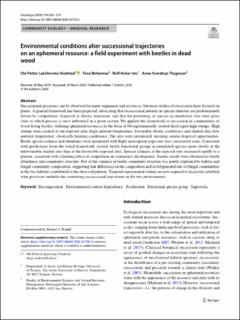| dc.contributor.author | Vindstad, Ole Petter Laksforsmo | |
| dc.contributor.author | Birkemoe, Tone | |
| dc.contributor.author | Ims, Rolf Anker | |
| dc.contributor.author | Sverdrup-Thygeson, Anne | |
| dc.date.accessioned | 2020-11-30T09:17:39Z | |
| dc.date.available | 2020-11-30T09:17:39Z | |
| dc.date.created | 2020-11-02T18:39:24Z | |
| dc.date.issued | 2020 | |
| dc.identifier.citation | Oecologia. 2020, 194, 205-219. | en_US |
| dc.identifier.issn | 0029-8549 | |
| dc.identifier.uri | https://hdl.handle.net/11250/2690100 | |
| dc.description.abstract | Successional processes can be observed for many organisms and resources, but most studies of succession have focused on plants. A general framework has been proposed, advocating that successional patterns in species turnover are predominantly driven by competition, dispersal or abiotic limitation, and that the patterning of species accumulation over time gives clues to which process is most influential in a given system. We applied this framework to succession in communities of wood-living beetles, utilizing ephemeral resources in the form of 60 experimentally created dead aspen high stumps. High stumps were created at sun-exposed sites (high ambient temperature; favourable abiotic conditions) and shaded sites (low ambient temperature; abiotically limiting conditions). The sites were intermixed, ensuring similar dispersal opportunities. Beetle species richness and abundance were monitored with flight interception traps over four consecutive years. Consistent with predictions from the tested framework, several beetle functional groups accumulated species more slowly at the unfavourable shaded sites than at the favourable exposed sites. Species richness at the exposed sites increased rapidly to a plateau, consistent with a limiting effect of competition on community development. Similar results were obtained for beetle abundance and community structure. Part of the variance in beetle community structure was jointly explained by habitat and fungal community composition, suggesting that differences in the composition and developmental rate of fungal communities in the two habitats contributed to the observed patterns. Targeted experimental studies are now required to decisively establish what processes underlie the contrasting successional trajectories in the two environments. | en_US |
| dc.language.iso | eng | en_US |
| dc.rights | Attribution-NonCommercial-NoDerivatives 4.0 Internasjonal | * |
| dc.rights.uri | http://creativecommons.org/licenses/by-nc-nd/4.0/deed.no | * |
| dc.title | Environmental conditions alter successional trajectories on an ephemeral resource: a field experiment with beetles in dead wood | en_US |
| dc.type | Peer reviewed | en_US |
| dc.type | Journal article | en_US |
| dc.description.version | publishedVersion | en_US |
| dc.source.pagenumber | 205-219 | en_US |
| dc.source.volume | 194 | en_US |
| dc.source.journal | Oecologia | en_US |
| dc.identifier.doi | 10.1007/s00442-020-04750-5 | |
| dc.identifier.cristin | 1844293 | |
| cristin.ispublished | true | |
| cristin.fulltext | original | |
| cristin.qualitycode | 1 | |

